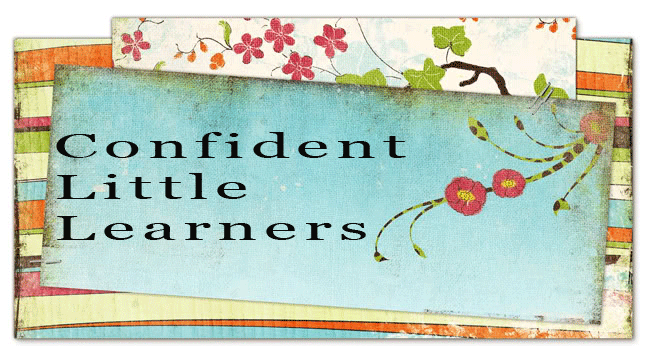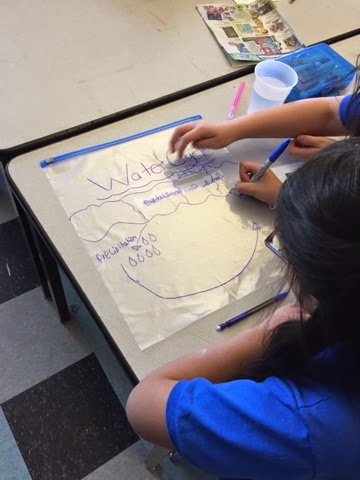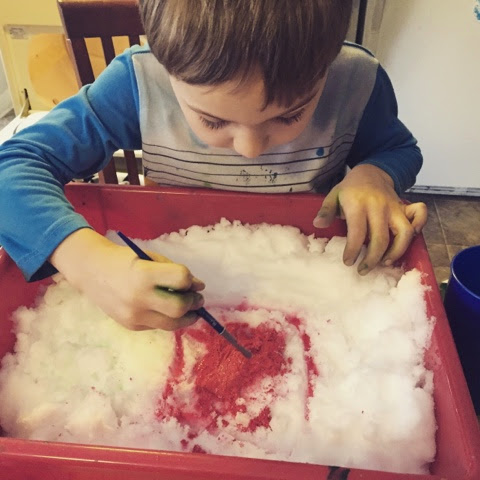Fifth grade :)
Wednesday, October 14, 2015
Strategy Tool Box
From the first day of school, students begin to build their math strategies and methods for solving problems. Each operation has its own methods. Throughout the years, students are to be building upon the previous years' strategies, building a "tool box" of strategies and methods.
In fifth grade, students seem to love to stick to certain strategies, even if they're not consistently getting them to the correct outcome. I have made many attempts to try to break them of these habits and encourage them to try out some new strategies. Maybe they will work better!
The great thing about math, is if you do the steps correctly, no matter what strategy you use, the outcome is always the same. Certain problems lend themselves better to specific strategies. What I have found while teaching math is that students, so often, stick to the same, stale strategies, even if they don't work out for certain problems.
My aim is to build their mental tool boxes. This bulletin board will be built upon little by little over the course of the year. I am fighting against "out of sight, out of mind" by bringing it into the classroom in a space where students can see them while doing work.
So far, students are referring to the tool box very often!
Try it out in your classroom and comment how it worked!
~Lisa :))
In fifth grade, students seem to love to stick to certain strategies, even if they're not consistently getting them to the correct outcome. I have made many attempts to try to break them of these habits and encourage them to try out some new strategies. Maybe they will work better!
The great thing about math, is if you do the steps correctly, no matter what strategy you use, the outcome is always the same. Certain problems lend themselves better to specific strategies. What I have found while teaching math is that students, so often, stick to the same, stale strategies, even if they don't work out for certain problems.
My aim is to build their mental tool boxes. This bulletin board will be built upon little by little over the course of the year. I am fighting against "out of sight, out of mind" by bringing it into the classroom in a space where students can see them while doing work.
So far, students are referring to the tool box very often!
Try it out in your classroom and comment how it worked!
~Lisa :))
Friday, March 6, 2015
Water Cycle in a Bag
Pinterest does it again. I get all the best ideas! Sorry I don't know who holds this idea originally but it's definitely not mine.
Within our weather and climate unit, my fifth grade scientists made Water Cycles in a Bag. Such a fun and easy experiment. AND a great way to watch the water cycle in action.
Wednesday, March 4, 2015
Top Down Web
Top down webs are a great way to organize information visually. According to Keys to Literacy, it allows students to better visualize the information and therefore have an easier time retaining it.
Here's one I made for science. We were studying the transfer of thermal energy through radiation, convection and conduction. This is on the wall in my classroom. The students also have this in their interactive science notebooks.
There are lots of rules regarding how it should be set up. Information should be presented using shapes. Research more on top down webs on the Keys to Literacy website.
Post your samples of top down webs!
Thursday, February 12, 2015
Effective Ways of Grouping Students
How do we put students into groups for tasks and centers? There are so many ways a teacher can choose to do this and something I've learned is that there is no "right" way. But there are more effective ways than others.
I have one very large math class. It is nearing 30 students and the ability levels run the gamut. I have very strong math students as well as very weak math students, who require very targeted a individualized instruction.
1. Mixed Ability Groups
I have found that the most effective groups are mixed ability groups....for some kids. My goal is always to keep the groups to 3 or 4. I try to put together 1 student who performs above average, 1 or 2 who are right on grade level in ability and 1 who is slightly below average in ability. I find that the student who is above average in ability is "forced" to explain him/herself when choosing a strategy. The process of explaining the steps he/she is taking and the way he/she is choosing to solve the problem helps that student develop the language skills needed to orally communicate problem solving strategies. The mid-level students can contribute at times and at others need to listen and strategize on their own. The slightly below average student will be pulled up by hearing the discussion and will (hopefully) apply the skills he/she is learning to another, similar, problem.
2. Similar Ability Groups
Groups of similar learners also serve a purpose. When doing a group activity where there are different levels of independent practice, the similar ability group can serve a very useful purpose. Students needing to be challenged can work on a more rigorous task designed to promote useful dialogue and debate between the students aimed at encouraging higher-order thinking.
When consistently below-average students work together - several useful outcomes can happen. One, I always recommend that a teacher sit and work directly with this group. A facilitator in the form of the classroom teacher serves to promote discussion and prompt the students when the conversation and debate stagnates. Also, within that low level group will be various abilities. There will always be 1 or 2 students who emerge as the "role model" in the group. When he/she is able to share their thought process in a more safe space, confidence is built. When a facilitator is working with underperforming students, the task can be very targeted toward that level of comprehension, with the goal being to bring the students up to the next level of understanding.
3. Pairs
When students work in pairs - something very special can happen. It is here that student begin to form bonds with students who are just like them in their learning. I like to pair students up who are at similar levels of ability and give a task that is targeted at the level that promotes higher order thinking.
**********************************************************************************
Whenever I was doing group work and circulating the room or working with one group, I was noticing several students off task. I know this is a common problem because I have talked with other teachers who have experienced the same thing in their classes. After some observation, I realized that it might have something to do with students not knowing how to work in a group. What happens when you disagree with someone in a group? What do you do if you don't have the interpersonal skills to work through it and come up with a solution to the problem at hand? Often, students will simply disengage and start discussing something else.
Below, is a document I created based on Reciprocal Reading groups protocol used by the ELA teachers on my team. I tweaked it a bit to be based on math group work. The self-assessment at the end is critical because it gives students the criteria for being a productive worker.
How do you like to group your students?
I have one very large math class. It is nearing 30 students and the ability levels run the gamut. I have very strong math students as well as very weak math students, who require very targeted a individualized instruction.
1. Mixed Ability Groups
I have found that the most effective groups are mixed ability groups....for some kids. My goal is always to keep the groups to 3 or 4. I try to put together 1 student who performs above average, 1 or 2 who are right on grade level in ability and 1 who is slightly below average in ability. I find that the student who is above average in ability is "forced" to explain him/herself when choosing a strategy. The process of explaining the steps he/she is taking and the way he/she is choosing to solve the problem helps that student develop the language skills needed to orally communicate problem solving strategies. The mid-level students can contribute at times and at others need to listen and strategize on their own. The slightly below average student will be pulled up by hearing the discussion and will (hopefully) apply the skills he/she is learning to another, similar, problem.
2. Similar Ability Groups
Groups of similar learners also serve a purpose. When doing a group activity where there are different levels of independent practice, the similar ability group can serve a very useful purpose. Students needing to be challenged can work on a more rigorous task designed to promote useful dialogue and debate between the students aimed at encouraging higher-order thinking.
When consistently below-average students work together - several useful outcomes can happen. One, I always recommend that a teacher sit and work directly with this group. A facilitator in the form of the classroom teacher serves to promote discussion and prompt the students when the conversation and debate stagnates. Also, within that low level group will be various abilities. There will always be 1 or 2 students who emerge as the "role model" in the group. When he/she is able to share their thought process in a more safe space, confidence is built. When a facilitator is working with underperforming students, the task can be very targeted toward that level of comprehension, with the goal being to bring the students up to the next level of understanding.
3. Pairs
When students work in pairs - something very special can happen. It is here that student begin to form bonds with students who are just like them in their learning. I like to pair students up who are at similar levels of ability and give a task that is targeted at the level that promotes higher order thinking.
**********************************************************************************
Whenever I was doing group work and circulating the room or working with one group, I was noticing several students off task. I know this is a common problem because I have talked with other teachers who have experienced the same thing in their classes. After some observation, I realized that it might have something to do with students not knowing how to work in a group. What happens when you disagree with someone in a group? What do you do if you don't have the interpersonal skills to work through it and come up with a solution to the problem at hand? Often, students will simply disengage and start discussing something else.
Below, is a document I created based on Reciprocal Reading groups protocol used by the ELA teachers on my team. I tweaked it a bit to be based on math group work. The self-assessment at the end is critical because it gives students the criteria for being a productive worker.
How do you like to group your students?
Monday, February 9, 2015
Snow Day Schooling
This morning, they were engaged for over 90 minutes painting with snow!
After they were done snow painting, we launched into an activity rooted in science. As they are only 3 and 6 they didn't know we were doing a science experiment on density and buoyancy. They just thought we were dumping objects in water. We got some great science vocabulary in there: "prediction" and "observation" : a great intro to the scientific method!
Thank God for Pinteret on snow days!!
Saturday, January 31, 2015
Subscribe to:
Posts (Atom)

















